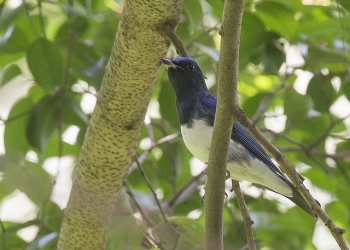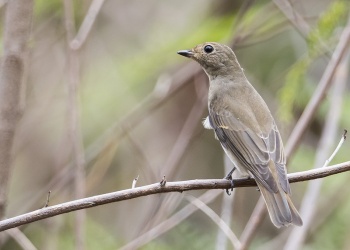Sbarnhardt (talk | contribs) (Add additional Gsearch for common name, add Gsearch checked template) |
(→External Links: New Combined GSearch. 1 added to GSChecked template) |
||
| Line 41: | Line 41: | ||
{{ref}} | {{ref}} | ||
==External Links== | ==External Links== | ||
| − | + | {{GSearch|"Cyanoptila cyanomelana" {{!}} "Blue-and-white Flycatcher"}} | |
| − | {{GSearch|Cyanoptila | + | {{GS-checked}}1 |
| − | + | <br /> | |
| − | + | <br /> | |
| − | {{GS-checked}} | + | |
[[Category:Birds]] [[Category:Cyanoptila]] | [[Category:Birds]] [[Category:Cyanoptila]] | ||
Latest revision as of 19:07, 13 October 2024
- Cyanoptila cyanomelana
Identification
16–17 cm (6¼-6¾ in).
Male has cobalt-blue upperparts, blackish head-sides, throat and breast with rest of underparts whitish.
Female has rather uniform brownish upperparts and breast with contrasting white belly and vent, whitish throat-patch and all black bill.
First-winter male resembles female but has blue wings, tail and back to uppertail-coverts.
Similar Species
Both male and first-winter male has a small whitish patch at the base of the outer tail feathers which can be used to separate it from the very similar looking Zappey's Flycatcher. This feature, however, may not be seen easily in the field as it may be obscured or covered by the primaries.
It is impossible to separate female from Zappey's Flycatcher in the field based on current knowledge.
Distribution
Asia: Russia, Siberia, China, India, Korea, Japan, Taiwan, Hong Kong
Southeast Asia: Indochina, Myanmar, Laos, Vietnam, Cambodia, Thailand, Malaysia, Borneo, Malay Peninsula, Brunei, Singapore, Philippines, Borneo, Indonesia, Greater Sundas, Sumatra, Java
Taxonomy
Zappey's Flycatcher was formerly included in this species.
Subspecies
2 subspecies are currently recognized[1]:
- C. c. cyanomelana:
- Breeds Japan and southern Kuril Islands; the species winters south to Myanmar, Thailand, and the Greater Sundas
- C. c. intermedia:
Habitat
Primary rainforest, Secondary forest, parkland and occasionally gardens. Low mountains.
Behaviour
Diet
They eat small insects such as beetles, moths and bees, also larva.
Breeding
Their nest is constructed mostly from moss, and is placed in a hole under an overhanging back, a cliff crevice or among tree roots.
Movements
Migratory.
References
- Clements, J. F., T. S. Schulenberg, M. J. Iliff, D. Roberson, T. A. Fredericks, B. L. Sullivan, and C. L. Wood. 2016. The eBird/Clements checklist of birds of the world: v2016, with updates to August 2016. Downloaded from http://www.birds.cornell.edu/clementschecklist/download/
- Gill, F and D Donsker (Eds). 2014. IOC World Bird Names (version 4.3). Available at http://www.worldbirdnames.org/.
- Avibase
- BF Member observations
- Birdforum thread discussing taxonomy of this species
Recommended Citation
- BirdForum Opus contributors. (2025) Blue-and-white Flycatcher. In: BirdForum, the forum for wild birds and birding. Retrieved 3 January 2025 from https://www.birdforum.net/opus/Blue-and-white_Flycatcher
External Links
GSearch checked for 2020 platform.1







